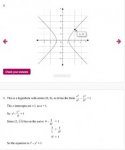To get quicker and less annoyed help in the future, please read
https://www.freemathhelp.com/forum/threads/112086-Guidelines-Summary?p=433156&viewfull=1#post433156
The major problem with your first post was that you did not give a complete and exact statement of the problem that you were supposed to answer.
Jomo's first post was a brief explanation of the answer to a problem that he had to guess.
So your second post is where you should have started. However, it is still not clear to me at least what you are confused about.
The given explanation expects that you will recognize that the graph is for a hyperbola centered on (0, 0). Is that what confuses you?
The entire family of such curves can be described by equations of the form
\(\displaystyle \dfrac{x^2}{a^2} - \dfrac{y^2}{b^2} = 1.\)
The given explanation expects that you will know that formula. Is that what confuses you?
With such a hyperbola, you can determine what \(\displaystyle a^2\) is from
either of the x-intercepts. At an intercept of the x-axis, y = 0 so \(\displaystyle b^2\) effectively plays no role. The x-intercepts are (-1, 0) and (1, 0). Whichever we choose x^2 = 1 and y^2 = 0. Put those values into the general equation.
\(\displaystyle \dfrac{1}{a^2} - \dfrac{0}{b^2} = 1 \implies \dfrac{1}{a^2} = 1 \implies a^2 = 1.\)
Any questions about that? So with respect to this specific hyperbola we can say
\(\displaystyle \dfrac{x^2}{a^2} - \dfrac{y^2}{b^2} = 1 \text { and } a^2 = 1 \implies \dfrac{x^2}{1} - \dfrac{y^2}{b^2} = 1 \implies x^2 - \dfrac{y^2}{b^2} = 1.\)
Now if we knew the coordinates of just one other point on this hyperbola, we could calculate the \(\displaystyle b^2\) for this specific hyperbola.
But the problem gives us such a point, namely by
telling us that the point \(\displaystyle \sqrt{3},\ 4)\) lies on this specific hyperbola. In other words, those specific values of x and y satisfy the equation.So
\(\displaystyle x^2 - \dfrac{y^2}{b^2} = 1, \ x = \sqrt{3} \text { and } y = 4 \implies\)
\(\displaystyle (\sqrt{3})^2 - \dfrac{4^2}{b^2} = 1 \implies 3 - \dfrac{16}{b^2} = 1 \implies \dfrac{16}{b^2} = 3 - 1 \implies \)
\(\displaystyle \dfrac{16}{b^2} = 2 \implies 2b^2 = 16 \implies b^2 = 8.\)
Therefore, this hyperbola has the equation \(\displaystyle x^2 - \dfrac{y^2}{8} = 1\).
If you look carefully, you will see that several posts have given a condensed version of this answer.
Are you still confused?









